Critical Analysis: Mass Media's Broadcasting vs. Participatory Culture
VerifiedAdded on 2022/08/18
|8
|1977
|12
Essay
AI Summary
This essay critically analyzes the influence and significance of mass media in both global and local societies, focusing on the transition from broadcasting to participatory culture. It identifies key concepts within the socio-historical perspective of media studies, exploring the relationship between science, technology, and culture. The essay contrasts broadcasting, characterized by a one-to-many model, with participatory culture, driven by individuals and social media. It discusses the impact of technological advancements, such as the internet and social media, on communication, expression, and public discourse. The essay also highlights the similarities and differences between traditional and modern media approaches, acknowledging the advantages and disadvantages of each. Furthermore, it touches upon the concept of technological determinism and concludes by emphasizing the role of mass media in societal development and change, referencing the historical impact of the printing press and the evolution of media devices, such as television and mobile phones. The essay utilizes various academic sources to support its arguments, including works by Bignell, Creeber, McLuhan, Murphie, Potts, and Winston.
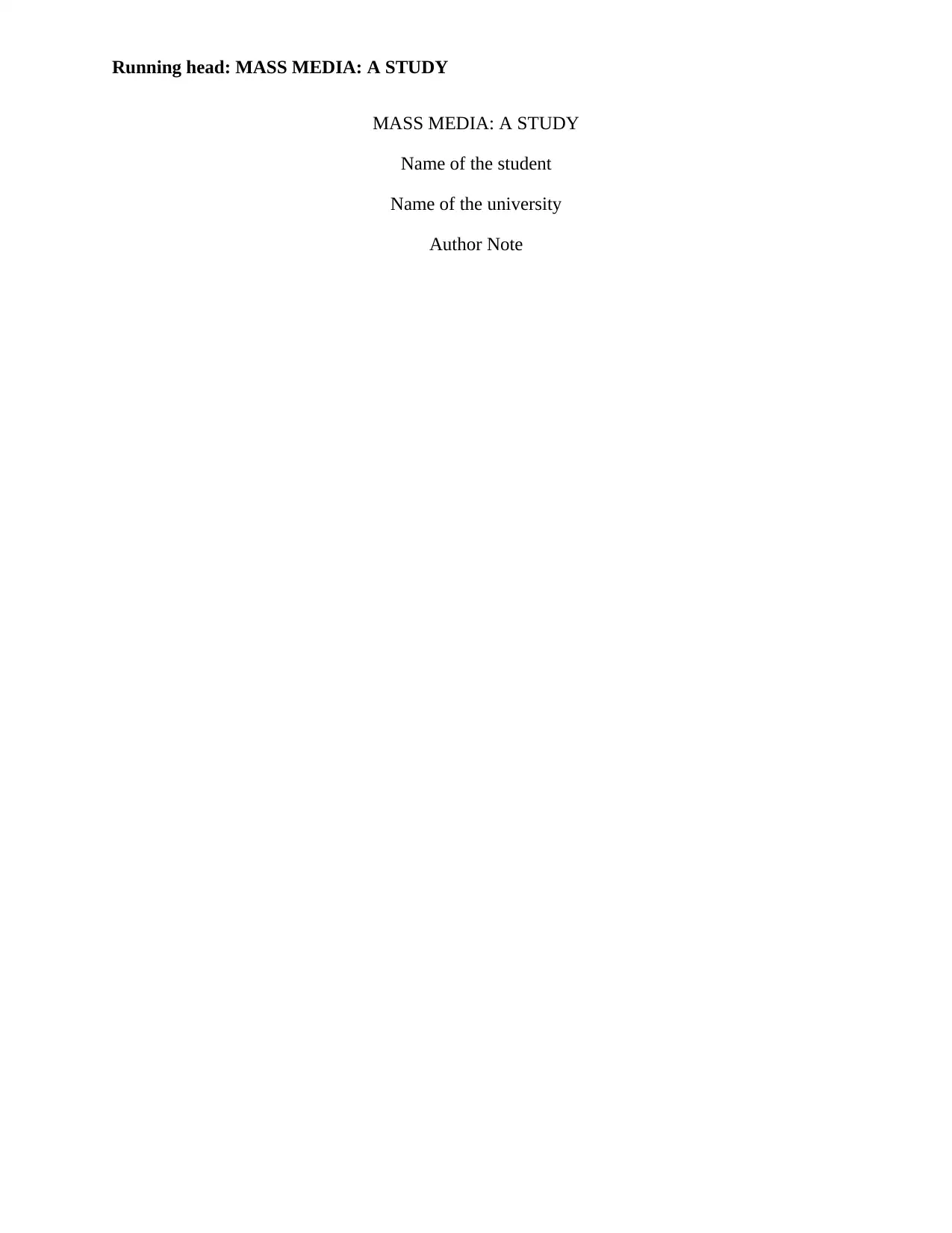
Running head: MASS MEDIA: A STUDY
MASS MEDIA: A STUDY
Name of the student
Name of the university
Author Note
MASS MEDIA: A STUDY
Name of the student
Name of the university
Author Note
Paraphrase This Document
Need a fresh take? Get an instant paraphrase of this document with our AI Paraphraser
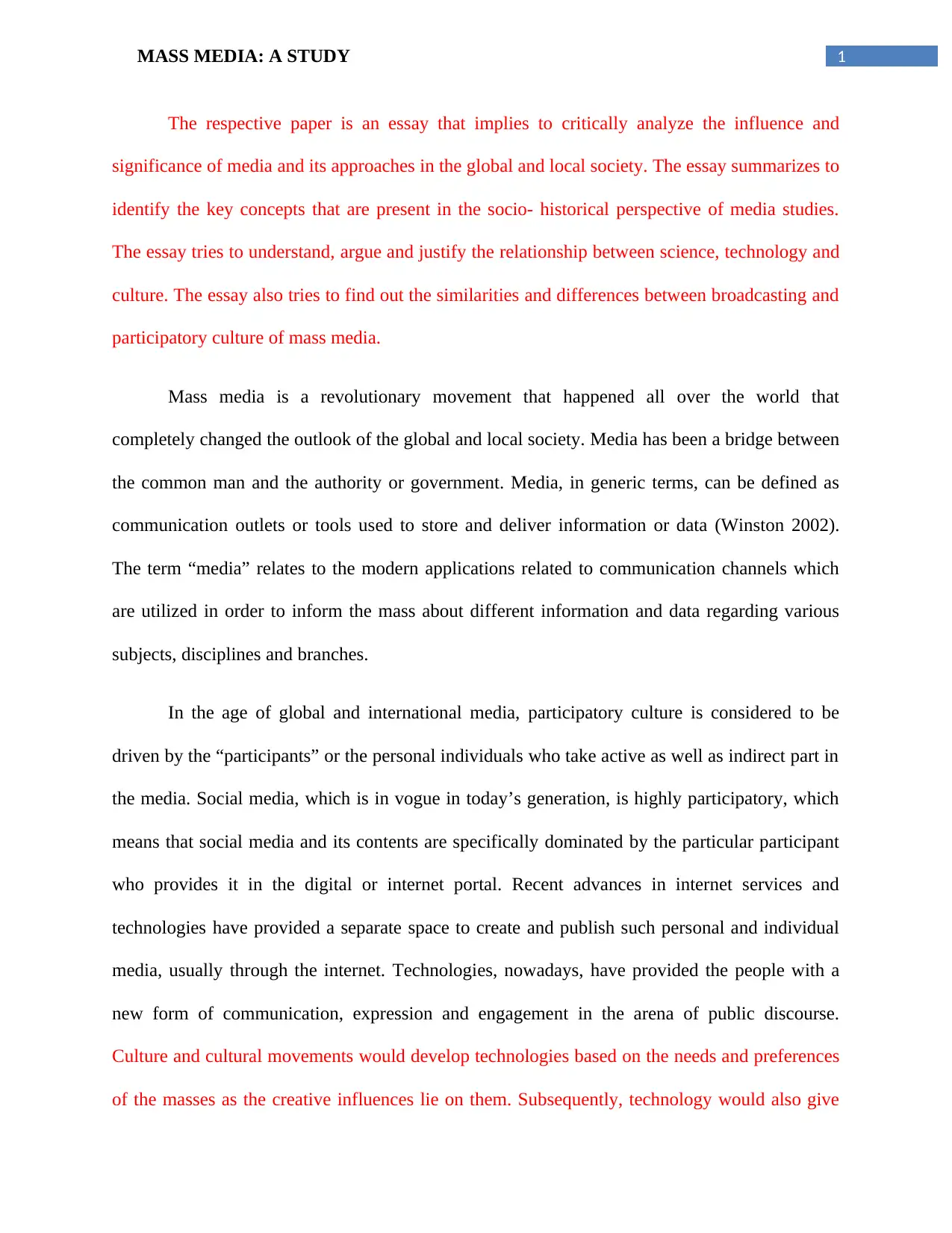
1MASS MEDIA: A STUDY
The respective paper is an essay that implies to critically analyze the influence and
significance of media and its approaches in the global and local society. The essay summarizes to
identify the key concepts that are present in the socio- historical perspective of media studies.
The essay tries to understand, argue and justify the relationship between science, technology and
culture. The essay also tries to find out the similarities and differences between broadcasting and
participatory culture of mass media.
Mass media is a revolutionary movement that happened all over the world that
completely changed the outlook of the global and local society. Media has been a bridge between
the common man and the authority or government. Media, in generic terms, can be defined as
communication outlets or tools used to store and deliver information or data (Winston 2002).
The term “media” relates to the modern applications related to communication channels which
are utilized in order to inform the mass about different information and data regarding various
subjects, disciplines and branches.
In the age of global and international media, participatory culture is considered to be
driven by the “participants” or the personal individuals who take active as well as indirect part in
the media. Social media, which is in vogue in today’s generation, is highly participatory, which
means that social media and its contents are specifically dominated by the particular participant
who provides it in the digital or internet portal. Recent advances in internet services and
technologies have provided a separate space to create and publish such personal and individual
media, usually through the internet. Technologies, nowadays, have provided the people with a
new form of communication, expression and engagement in the arena of public discourse.
Culture and cultural movements would develop technologies based on the needs and preferences
of the masses as the creative influences lie on them. Subsequently, technology would also give
The respective paper is an essay that implies to critically analyze the influence and
significance of media and its approaches in the global and local society. The essay summarizes to
identify the key concepts that are present in the socio- historical perspective of media studies.
The essay tries to understand, argue and justify the relationship between science, technology and
culture. The essay also tries to find out the similarities and differences between broadcasting and
participatory culture of mass media.
Mass media is a revolutionary movement that happened all over the world that
completely changed the outlook of the global and local society. Media has been a bridge between
the common man and the authority or government. Media, in generic terms, can be defined as
communication outlets or tools used to store and deliver information or data (Winston 2002).
The term “media” relates to the modern applications related to communication channels which
are utilized in order to inform the mass about different information and data regarding various
subjects, disciplines and branches.
In the age of global and international media, participatory culture is considered to be
driven by the “participants” or the personal individuals who take active as well as indirect part in
the media. Social media, which is in vogue in today’s generation, is highly participatory, which
means that social media and its contents are specifically dominated by the particular participant
who provides it in the digital or internet portal. Recent advances in internet services and
technologies have provided a separate space to create and publish such personal and individual
media, usually through the internet. Technologies, nowadays, have provided the people with a
new form of communication, expression and engagement in the arena of public discourse.
Culture and cultural movements would develop technologies based on the needs and preferences
of the masses as the creative influences lie on them. Subsequently, technology would also give
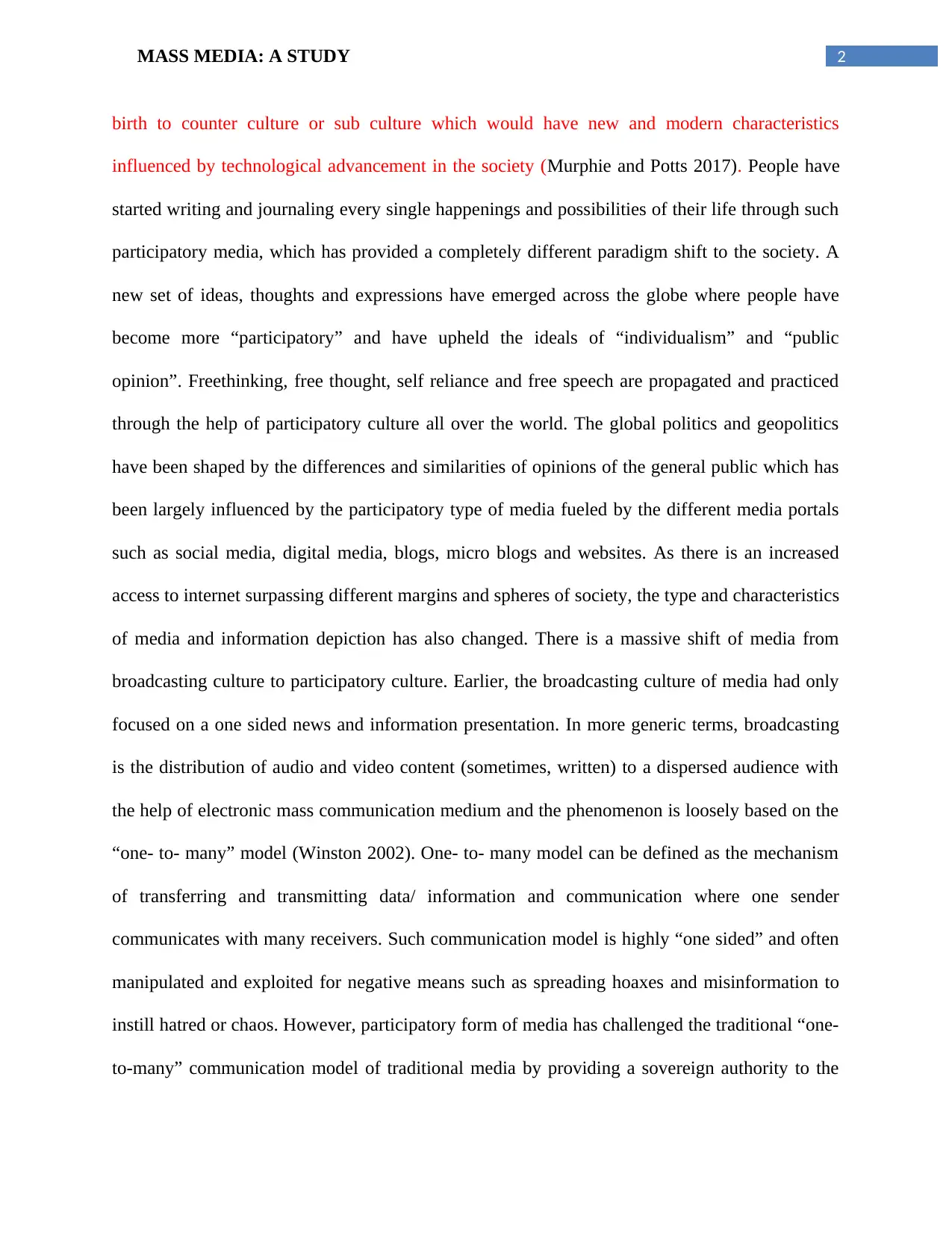
2MASS MEDIA: A STUDY
birth to counter culture or sub culture which would have new and modern characteristics
influenced by technological advancement in the society (Murphie and Potts 2017). People have
started writing and journaling every single happenings and possibilities of their life through such
participatory media, which has provided a completely different paradigm shift to the society. A
new set of ideas, thoughts and expressions have emerged across the globe where people have
become more “participatory” and have upheld the ideals of “individualism” and “public
opinion”. Freethinking, free thought, self reliance and free speech are propagated and practiced
through the help of participatory culture all over the world. The global politics and geopolitics
have been shaped by the differences and similarities of opinions of the general public which has
been largely influenced by the participatory type of media fueled by the different media portals
such as social media, digital media, blogs, micro blogs and websites. As there is an increased
access to internet surpassing different margins and spheres of society, the type and characteristics
of media and information depiction has also changed. There is a massive shift of media from
broadcasting culture to participatory culture. Earlier, the broadcasting culture of media had only
focused on a one sided news and information presentation. In more generic terms, broadcasting
is the distribution of audio and video content (sometimes, written) to a dispersed audience with
the help of electronic mass communication medium and the phenomenon is loosely based on the
“one- to- many” model (Winston 2002). One- to- many model can be defined as the mechanism
of transferring and transmitting data/ information and communication where one sender
communicates with many receivers. Such communication model is highly “one sided” and often
manipulated and exploited for negative means such as spreading hoaxes and misinformation to
instill hatred or chaos. However, participatory form of media has challenged the traditional “one-
to-many” communication model of traditional media by providing a sovereign authority to the
birth to counter culture or sub culture which would have new and modern characteristics
influenced by technological advancement in the society (Murphie and Potts 2017). People have
started writing and journaling every single happenings and possibilities of their life through such
participatory media, which has provided a completely different paradigm shift to the society. A
new set of ideas, thoughts and expressions have emerged across the globe where people have
become more “participatory” and have upheld the ideals of “individualism” and “public
opinion”. Freethinking, free thought, self reliance and free speech are propagated and practiced
through the help of participatory culture all over the world. The global politics and geopolitics
have been shaped by the differences and similarities of opinions of the general public which has
been largely influenced by the participatory type of media fueled by the different media portals
such as social media, digital media, blogs, micro blogs and websites. As there is an increased
access to internet surpassing different margins and spheres of society, the type and characteristics
of media and information depiction has also changed. There is a massive shift of media from
broadcasting culture to participatory culture. Earlier, the broadcasting culture of media had only
focused on a one sided news and information presentation. In more generic terms, broadcasting
is the distribution of audio and video content (sometimes, written) to a dispersed audience with
the help of electronic mass communication medium and the phenomenon is loosely based on the
“one- to- many” model (Winston 2002). One- to- many model can be defined as the mechanism
of transferring and transmitting data/ information and communication where one sender
communicates with many receivers. Such communication model is highly “one sided” and often
manipulated and exploited for negative means such as spreading hoaxes and misinformation to
instill hatred or chaos. However, participatory form of media has challenged the traditional “one-
to-many” communication model of traditional media by providing a sovereign authority to the
⊘ This is a preview!⊘
Do you want full access?
Subscribe today to unlock all pages.

Trusted by 1+ million students worldwide
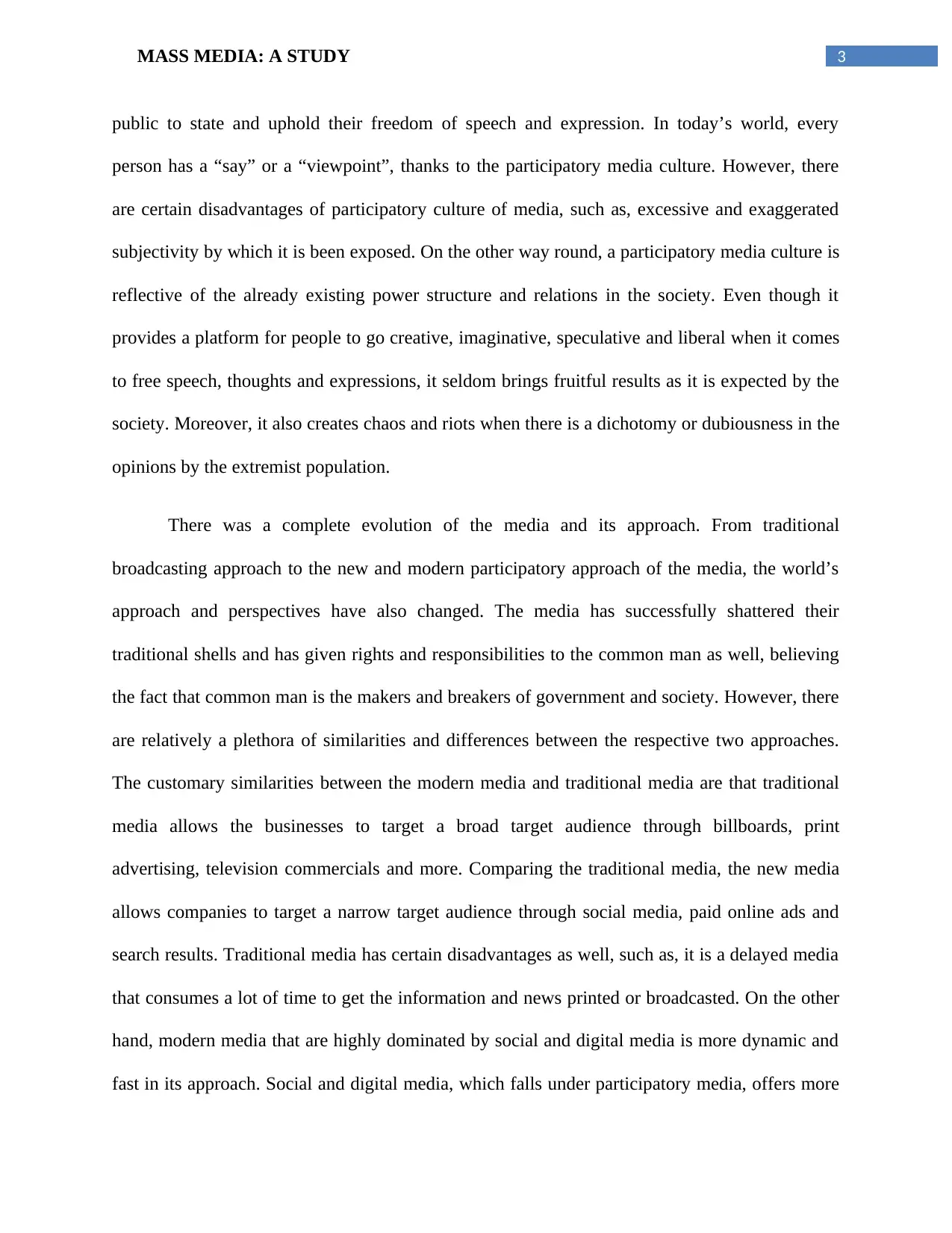
3MASS MEDIA: A STUDY
public to state and uphold their freedom of speech and expression. In today’s world, every
person has a “say” or a “viewpoint”, thanks to the participatory media culture. However, there
are certain disadvantages of participatory culture of media, such as, excessive and exaggerated
subjectivity by which it is been exposed. On the other way round, a participatory media culture is
reflective of the already existing power structure and relations in the society. Even though it
provides a platform for people to go creative, imaginative, speculative and liberal when it comes
to free speech, thoughts and expressions, it seldom brings fruitful results as it is expected by the
society. Moreover, it also creates chaos and riots when there is a dichotomy or dubiousness in the
opinions by the extremist population.
There was a complete evolution of the media and its approach. From traditional
broadcasting approach to the new and modern participatory approach of the media, the world’s
approach and perspectives have also changed. The media has successfully shattered their
traditional shells and has given rights and responsibilities to the common man as well, believing
the fact that common man is the makers and breakers of government and society. However, there
are relatively a plethora of similarities and differences between the respective two approaches.
The customary similarities between the modern media and traditional media are that traditional
media allows the businesses to target a broad target audience through billboards, print
advertising, television commercials and more. Comparing the traditional media, the new media
allows companies to target a narrow target audience through social media, paid online ads and
search results. Traditional media has certain disadvantages as well, such as, it is a delayed media
that consumes a lot of time to get the information and news printed or broadcasted. On the other
hand, modern media that are highly dominated by social and digital media is more dynamic and
fast in its approach. Social and digital media, which falls under participatory media, offers more
public to state and uphold their freedom of speech and expression. In today’s world, every
person has a “say” or a “viewpoint”, thanks to the participatory media culture. However, there
are certain disadvantages of participatory culture of media, such as, excessive and exaggerated
subjectivity by which it is been exposed. On the other way round, a participatory media culture is
reflective of the already existing power structure and relations in the society. Even though it
provides a platform for people to go creative, imaginative, speculative and liberal when it comes
to free speech, thoughts and expressions, it seldom brings fruitful results as it is expected by the
society. Moreover, it also creates chaos and riots when there is a dichotomy or dubiousness in the
opinions by the extremist population.
There was a complete evolution of the media and its approach. From traditional
broadcasting approach to the new and modern participatory approach of the media, the world’s
approach and perspectives have also changed. The media has successfully shattered their
traditional shells and has given rights and responsibilities to the common man as well, believing
the fact that common man is the makers and breakers of government and society. However, there
are relatively a plethora of similarities and differences between the respective two approaches.
The customary similarities between the modern media and traditional media are that traditional
media allows the businesses to target a broad target audience through billboards, print
advertising, television commercials and more. Comparing the traditional media, the new media
allows companies to target a narrow target audience through social media, paid online ads and
search results. Traditional media has certain disadvantages as well, such as, it is a delayed media
that consumes a lot of time to get the information and news printed or broadcasted. On the other
hand, modern media that are highly dominated by social and digital media is more dynamic and
fast in its approach. Social and digital media, which falls under participatory media, offers more
Paraphrase This Document
Need a fresh take? Get an instant paraphrase of this document with our AI Paraphraser
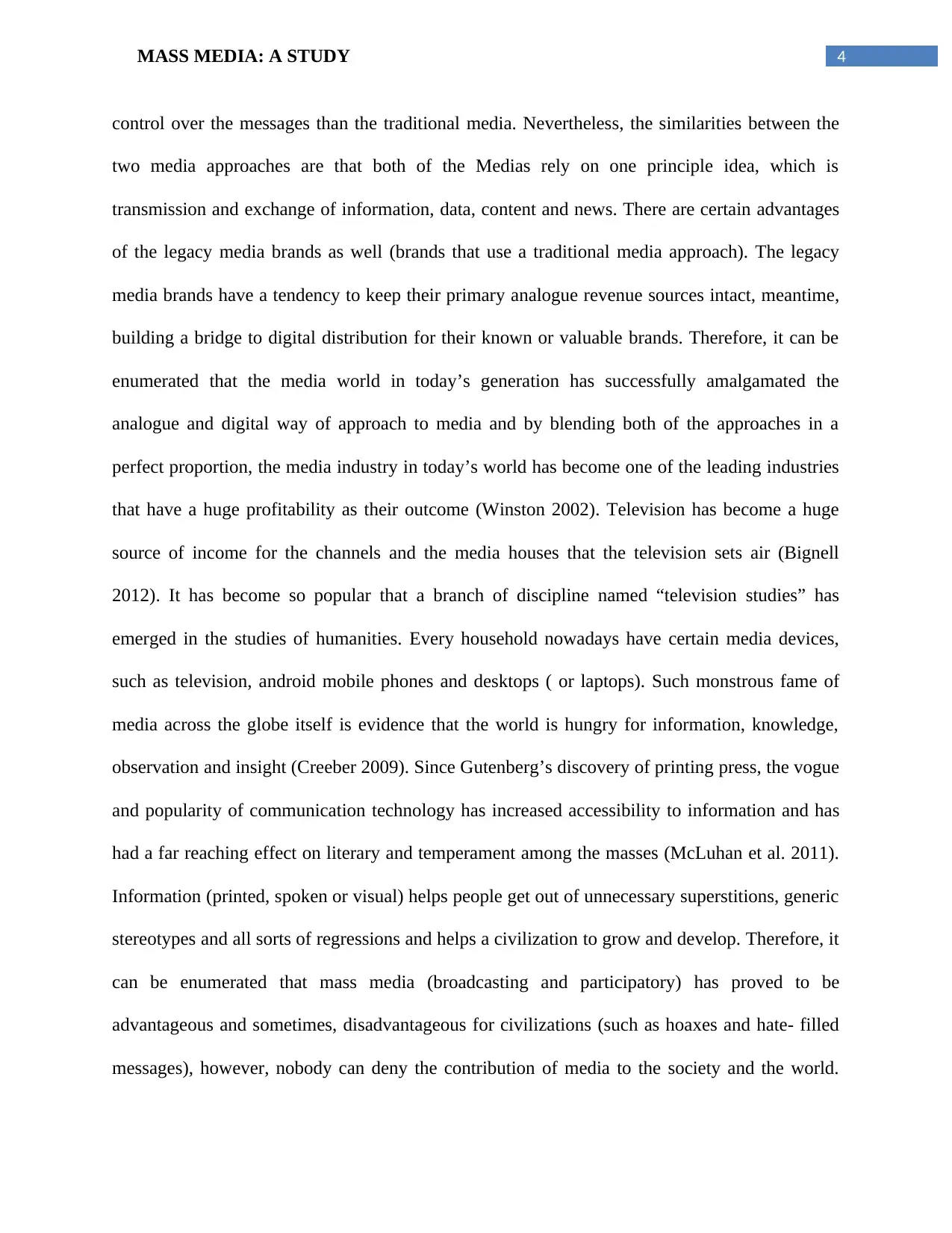
4MASS MEDIA: A STUDY
control over the messages than the traditional media. Nevertheless, the similarities between the
two media approaches are that both of the Medias rely on one principle idea, which is
transmission and exchange of information, data, content and news. There are certain advantages
of the legacy media brands as well (brands that use a traditional media approach). The legacy
media brands have a tendency to keep their primary analogue revenue sources intact, meantime,
building a bridge to digital distribution for their known or valuable brands. Therefore, it can be
enumerated that the media world in today’s generation has successfully amalgamated the
analogue and digital way of approach to media and by blending both of the approaches in a
perfect proportion, the media industry in today’s world has become one of the leading industries
that have a huge profitability as their outcome (Winston 2002). Television has become a huge
source of income for the channels and the media houses that the television sets air (Bignell
2012). It has become so popular that a branch of discipline named “television studies” has
emerged in the studies of humanities. Every household nowadays have certain media devices,
such as television, android mobile phones and desktops ( or laptops). Such monstrous fame of
media across the globe itself is evidence that the world is hungry for information, knowledge,
observation and insight (Creeber 2009). Since Gutenberg’s discovery of printing press, the vogue
and popularity of communication technology has increased accessibility to information and has
had a far reaching effect on literary and temperament among the masses (McLuhan et al. 2011).
Information (printed, spoken or visual) helps people get out of unnecessary superstitions, generic
stereotypes and all sorts of regressions and helps a civilization to grow and develop. Therefore, it
can be enumerated that mass media (broadcasting and participatory) has proved to be
advantageous and sometimes, disadvantageous for civilizations (such as hoaxes and hate- filled
messages), however, nobody can deny the contribution of media to the society and the world.
control over the messages than the traditional media. Nevertheless, the similarities between the
two media approaches are that both of the Medias rely on one principle idea, which is
transmission and exchange of information, data, content and news. There are certain advantages
of the legacy media brands as well (brands that use a traditional media approach). The legacy
media brands have a tendency to keep their primary analogue revenue sources intact, meantime,
building a bridge to digital distribution for their known or valuable brands. Therefore, it can be
enumerated that the media world in today’s generation has successfully amalgamated the
analogue and digital way of approach to media and by blending both of the approaches in a
perfect proportion, the media industry in today’s world has become one of the leading industries
that have a huge profitability as their outcome (Winston 2002). Television has become a huge
source of income for the channels and the media houses that the television sets air (Bignell
2012). It has become so popular that a branch of discipline named “television studies” has
emerged in the studies of humanities. Every household nowadays have certain media devices,
such as television, android mobile phones and desktops ( or laptops). Such monstrous fame of
media across the globe itself is evidence that the world is hungry for information, knowledge,
observation and insight (Creeber 2009). Since Gutenberg’s discovery of printing press, the vogue
and popularity of communication technology has increased accessibility to information and has
had a far reaching effect on literary and temperament among the masses (McLuhan et al. 2011).
Information (printed, spoken or visual) helps people get out of unnecessary superstitions, generic
stereotypes and all sorts of regressions and helps a civilization to grow and develop. Therefore, it
can be enumerated that mass media (broadcasting and participatory) has proved to be
advantageous and sometimes, disadvantageous for civilizations (such as hoaxes and hate- filled
messages), however, nobody can deny the contribution of media to the society and the world.
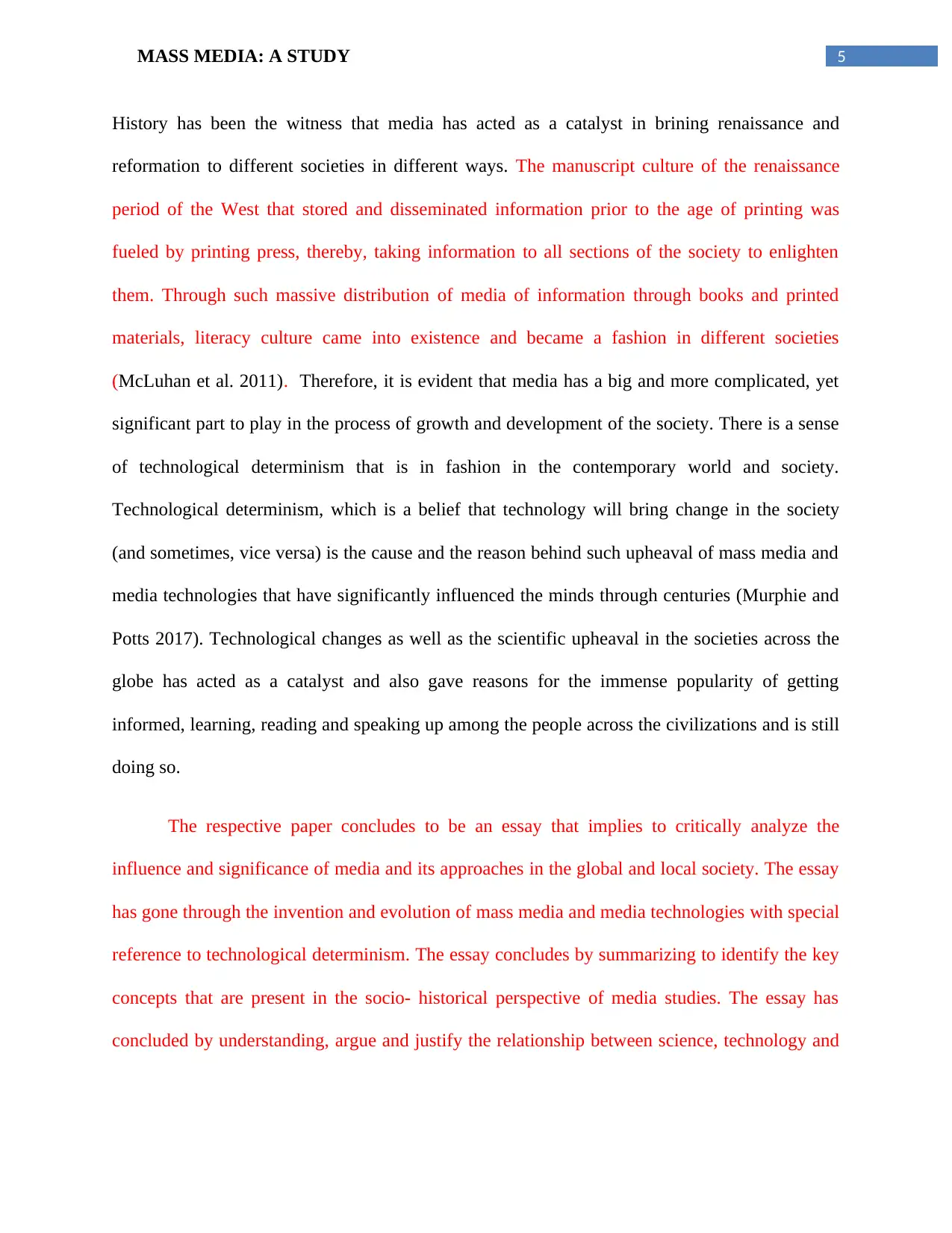
5MASS MEDIA: A STUDY
History has been the witness that media has acted as a catalyst in brining renaissance and
reformation to different societies in different ways. The manuscript culture of the renaissance
period of the West that stored and disseminated information prior to the age of printing was
fueled by printing press, thereby, taking information to all sections of the society to enlighten
them. Through such massive distribution of media of information through books and printed
materials, literacy culture came into existence and became a fashion in different societies
(McLuhan et al. 2011). Therefore, it is evident that media has a big and more complicated, yet
significant part to play in the process of growth and development of the society. There is a sense
of technological determinism that is in fashion in the contemporary world and society.
Technological determinism, which is a belief that technology will bring change in the society
(and sometimes, vice versa) is the cause and the reason behind such upheaval of mass media and
media technologies that have significantly influenced the minds through centuries (Murphie and
Potts 2017). Technological changes as well as the scientific upheaval in the societies across the
globe has acted as a catalyst and also gave reasons for the immense popularity of getting
informed, learning, reading and speaking up among the people across the civilizations and is still
doing so.
The respective paper concludes to be an essay that implies to critically analyze the
influence and significance of media and its approaches in the global and local society. The essay
has gone through the invention and evolution of mass media and media technologies with special
reference to technological determinism. The essay concludes by summarizing to identify the key
concepts that are present in the socio- historical perspective of media studies. The essay has
concluded by understanding, argue and justify the relationship between science, technology and
History has been the witness that media has acted as a catalyst in brining renaissance and
reformation to different societies in different ways. The manuscript culture of the renaissance
period of the West that stored and disseminated information prior to the age of printing was
fueled by printing press, thereby, taking information to all sections of the society to enlighten
them. Through such massive distribution of media of information through books and printed
materials, literacy culture came into existence and became a fashion in different societies
(McLuhan et al. 2011). Therefore, it is evident that media has a big and more complicated, yet
significant part to play in the process of growth and development of the society. There is a sense
of technological determinism that is in fashion in the contemporary world and society.
Technological determinism, which is a belief that technology will bring change in the society
(and sometimes, vice versa) is the cause and the reason behind such upheaval of mass media and
media technologies that have significantly influenced the minds through centuries (Murphie and
Potts 2017). Technological changes as well as the scientific upheaval in the societies across the
globe has acted as a catalyst and also gave reasons for the immense popularity of getting
informed, learning, reading and speaking up among the people across the civilizations and is still
doing so.
The respective paper concludes to be an essay that implies to critically analyze the
influence and significance of media and its approaches in the global and local society. The essay
has gone through the invention and evolution of mass media and media technologies with special
reference to technological determinism. The essay concludes by summarizing to identify the key
concepts that are present in the socio- historical perspective of media studies. The essay has
concluded by understanding, argue and justify the relationship between science, technology and
⊘ This is a preview!⊘
Do you want full access?
Subscribe today to unlock all pages.

Trusted by 1+ million students worldwide

6MASS MEDIA: A STUDY
culture. The essay has also found out the similarities and differences between broadcasting and
participatory culture of mass media.
culture. The essay has also found out the similarities and differences between broadcasting and
participatory culture of mass media.
Paraphrase This Document
Need a fresh take? Get an instant paraphrase of this document with our AI Paraphraser
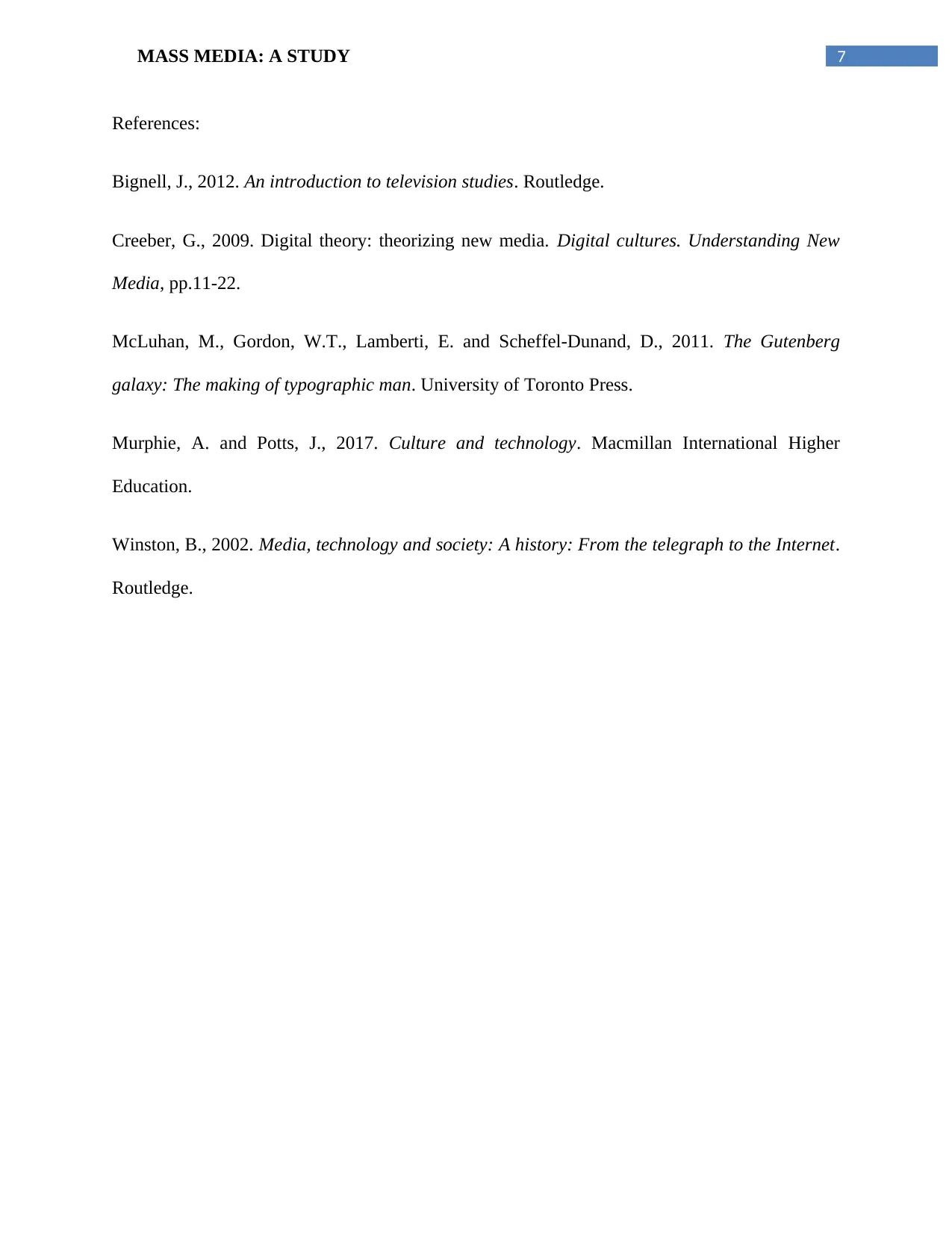
7MASS MEDIA: A STUDY
References:
Bignell, J., 2012. An introduction to television studies. Routledge.
Creeber, G., 2009. Digital theory: theorizing new media. Digital cultures. Understanding New
Media, pp.11-22.
McLuhan, M., Gordon, W.T., Lamberti, E. and Scheffel-Dunand, D., 2011. The Gutenberg
galaxy: The making of typographic man. University of Toronto Press.
Murphie, A. and Potts, J., 2017. Culture and technology. Macmillan International Higher
Education.
Winston, B., 2002. Media, technology and society: A history: From the telegraph to the Internet.
Routledge.
References:
Bignell, J., 2012. An introduction to television studies. Routledge.
Creeber, G., 2009. Digital theory: theorizing new media. Digital cultures. Understanding New
Media, pp.11-22.
McLuhan, M., Gordon, W.T., Lamberti, E. and Scheffel-Dunand, D., 2011. The Gutenberg
galaxy: The making of typographic man. University of Toronto Press.
Murphie, A. and Potts, J., 2017. Culture and technology. Macmillan International Higher
Education.
Winston, B., 2002. Media, technology and society: A history: From the telegraph to the Internet.
Routledge.
1 out of 8
Related Documents
Your All-in-One AI-Powered Toolkit for Academic Success.
+13062052269
info@desklib.com
Available 24*7 on WhatsApp / Email
![[object Object]](/_next/static/media/star-bottom.7253800d.svg)
Unlock your academic potential
Copyright © 2020–2025 A2Z Services. All Rights Reserved. Developed and managed by ZUCOL.




